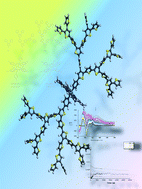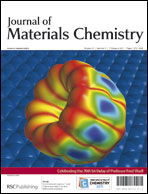Six supramolecular electron donor–acceptor hybrids, based on a ruthenium(II) phthalocyanine [RuPc] coordinating different dendritic oligothiophene (DOT) ligands [Py-nT] (n = 3, 9, 21) in either one [RuPcCO(Py-nT)] or two [RuPc(Py-nT)2] axial positions, have been characterized by standard spectroscopic methods and their photophysical behavior has been established by using ultrafast and fast time-resolved techniques. Based on the spectrochemical and radiolytically generated [Py-nT] (i.e., one-electron reduction of [Py-nT]) and [RuPcCO(Py) or RuPc(Py)2] (i.e., one-electron oxidation of [RuPcCO(Py) or RuPc(Py)2]) features, the deactivation processes were assigned to a solvent independent energy transfer in RuPcCO(Py-3T) and RuPc(Py-3T)2 and a strongly solvent dependent charge transfer mechanism, which competes with the energy transfer and the intersystem crossing for RuPcCO(Py-9T), RuPc(Py-9T)2, RuPcCO(Py-21T) and RuPc(Py-21T)2.
You have access to this article
 Please wait while we load your content...
Something went wrong. Try again?
Please wait while we load your content...
Something went wrong. Try again?


 Please wait while we load your content...
Please wait while we load your content...